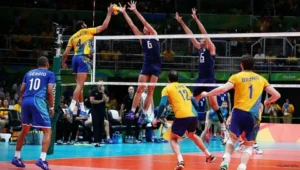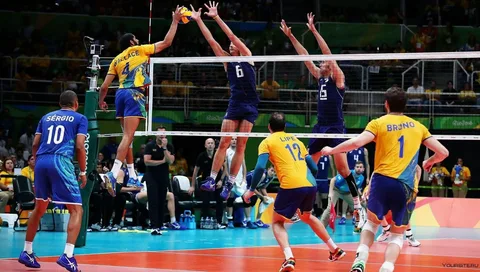How to Play Volleyball Like a Pro: A Beginner’s Guide to Game Basics and Techniques

Volleyball isn’t just a fun game; it’s a sport that combines athleticism, teamwork, and strategy. Whether you’re looking to play recreationally on a beach or competitively in a gym, knowing how to play volleyball can elevate your experience. This guide is designed to give beginners an easy-to-understand breakdown of the game. From understanding basic rules to refining essential skills like serving and setting, you’ll find everything you need to get started. So, let’s jump in!
Understanding the Basics of Volleyball
Before diving into the game, it’s essential to know a few fundamentals, like the basic rules, positions, and scoring system. Learning these basics will set a solid foundation for your volleyball journey.
Basic Rules of Volleyball
Teams and Players: Volleyball is typically played between two teams with six players on each side.
Objective: The main goal? Score points by making sure the ball hits the opponent’s court while preventing it from touching your own.
Serving: To start the game, one team serves the ball over the net.
Rallies: Each team can touch the ball three times before it must go over the net.
Winning a Set: A set is won by the team that scores 25 points first, with at least a two-point lead. Matches are typically played as a best of five sets.
## Positions and Roles
Each position on a volleyball team has a unique role. Understanding these positions will help you grasp how to play volleyball effectively.
Key Positions in Volleyball
Setter: Often called the “quarterback” of the team, the setter controls the flow by setting up the ball for the hitters.
Libero: A defensive specialist who wears a different color jersey and focuses on receiving serves and digging (defending).
Outside Hitter: This player handles both attacking and defensive duties on the left side.
Middle Blocker: Positioned near the net, the middle blocker is responsible for blocking the opposing team’s hits.
Opposite Hitter: Plays on the right side and complements the setter, often used for attacking and blocking.
Each of these positions requires specific skills, but beginners can start by learning the general movements and techniques common to all positions.
Essential Techniques to Learn When You’re Learning How to Play Volleyball
Knowing the rules and positions is one thing, but learning the techniques is where you’ll really shine. Let’s dive into the primary skills you’ll need to master as you learn how to play volleyball.
Serving: Start Strong
The serve starts each rally, and mastering it is essential. There are a few types of serves you’ll want to learn:
Underhand Serve: Great for beginners, this serve involves swinging your arm under the ball to send it over the net.
Overhand Serve: The most common serve, where you throw the ball up and hit it with an overhand motion.
Jump Serve: For advanced players, this powerful serve combines a jump with an overhand hit for maximum speed.
### Passing: The Art of Control
Passing, also known as bumping, is the technique used to receive serves and direct the ball toward the setter.
Ready Position: Stand with your feet shoulder-width apart, knees slightly bent.
Platform: Bring your arms together, with hands wrapped, creating a flat platform for the ball to hit.
Direct the Pass: Angle your platform to control where the ball goes. Aim to send it toward your setter.
### Setting: The Key to Team Coordination
Setting up your team for a successful attack is crucial. Good setting leads to better hits and more points.
Hand Position: Position your hands in a triangle above your forehead.
Timing: Wait for the ball, then push it upwards with a smooth, controlled motion.
Accuracy: Aim to place the ball precisely where your hitter can spike it.
# Spiking: The Powerful Finish
Spiking, or hitting, is how most points are scored in volleyball. It’s an aggressive move designed to send the ball forcefully into the opponent’s court.
Approach: Take a few steps toward the ball to gain momentum.
Jump and Swing: Jump, swing your arm back, and hit the ball with the palm of your hand.
Follow Through: Make sure your hand follows through in the direction you want the ball to go.
Blocking and Digging: Defense Wins Games
A solid defense is essential to prevent the opposing team from scoring.
Blocking: Position yourself at the net and jump to prevent the opponent’s spike from crossing into your side.
Digging: This technique involves saving a ball close to the ground, often after a spike. Use a low stance and quick reflexes to keep the ball in play.
How to Improve Your Game
Once you’ve mastered the basics, it’s time to refine your skills. Here are a few tips to elevate your game to the next level.
Communication is Key
In volleyball, communication is crucial. Always call out when you’re going for the ball, as well as when you need help from a teammate. Strong communication builds trust and ensures everyone is on the same page.
Focus on Footwork
Footwork is often overlooked, but it plays a huge role in positioning. Practicing your footwork will help you get into the right position faster, whether you’re setting, spiking, or digging.
Develop Court Awareness
Court awareness is knowing where you, your teammates, and opponents are at all times. Keep an eye on the opposing players’ positioning to anticipate their next moves.
Common Mistakes to Avoid When Learning How to Play Volleyball
When learning how to play volleyball, you’ll make mistakes, but that’s part of the learning process. Here’s a look at some common errors to watch out for and how to fix them.
Overuse of Arms in Passing: Remember, volleyball is all about control. Avoid swinging your arms wildly when passing.
Improper Foot Placement: Staying flat-footed can make you slower. Stay on your toes for faster movement.
Not Communicating: Silence on the court leads to confusion. Speak up!
## FAQs About How to Play Volleyball
Here are answers to some common questions about learning how to play volleyball:
1. How many players are on a volleyball team?
Each team has six players on the court at a time.
2. Can I hit the ball with my foot?
Yes, you can legally hit the ball with any part of your body, including your foot.
3. What’s the difference between indoor and beach volleyball?
Beach volleyball is played with two players per team, while indoor volleyball has six players per team. The court size and ball are also different.
4. What’s the best way to improve my volleyball skills?
Practice regularly, focus on each technique, and don’t be afraid to make mistakes. Watching volleyball matches can also give you insight into strategies and skills.
Conclusion
Learning how to play volleyball is a journey that combines skill, teamwork, and practice. Starting with the basics—like understanding the rules, positions, and essential techniques—will build your foundation. From serving to spiking, each aspect of the game offers a unique challenge, but with dedication, anyone can improve. Remember to keep communicating with your teammates, focus on your footwork, and most importantly, have fun!
Whether you’re aiming to play in tournaments or just want to enjoy a game with friends, following these tips and techniques on how to play volleyball will set you on the right path. Happy playing!
